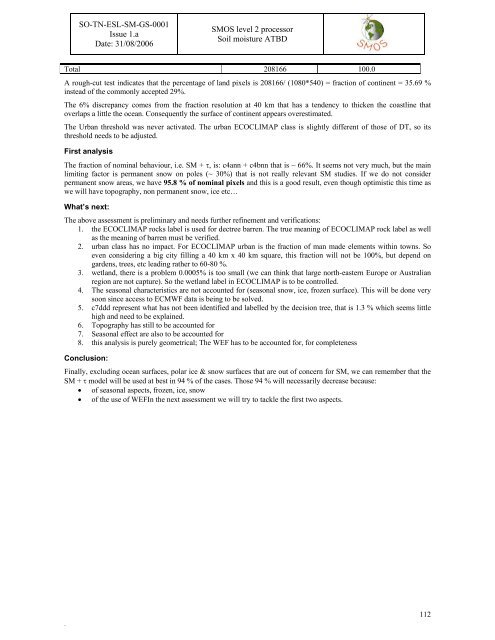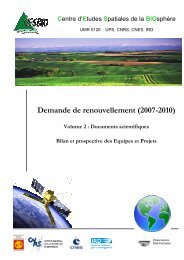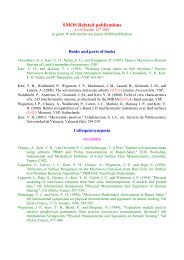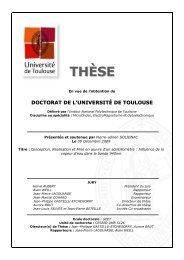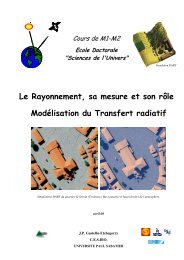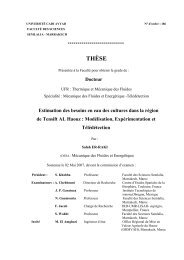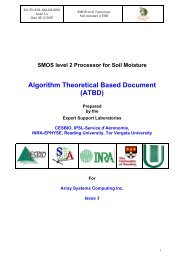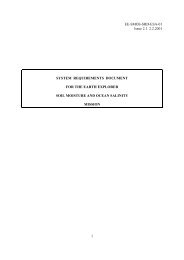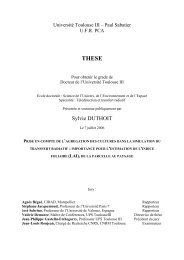Algorithm Theoretical Based Document (ATBD) - CESBIO
Algorithm Theoretical Based Document (ATBD) - CESBIO
Algorithm Theoretical Based Document (ATBD) - CESBIO
Create successful ePaper yourself
Turn your PDF publications into a flip-book with our unique Google optimized e-Paper software.
SO-TN-ESL-SM-GS-0001<br />
Issue 1.a<br />
Date: 31/08/2006<br />
SMOS level 2 processor<br />
Soil moisture <strong>ATBD</strong><br />
Total 208166 100.0<br />
A rough-cut test indicates that the percentage of land pixels is 208166/ (1080*540) = fraction of continent = 35.69 %<br />
instead of the commonly accepted 29%.<br />
The 6% discrepancy comes from the fraction resolution at 40 km that has a tendency to thicken the coastline that<br />
overlaps a little the ocean. Consequently the surface of continent appears overestimated.<br />
The Urban threshold was never activated. The urban ECOCLIMAP class is slightly different of those of DT, so its<br />
threshold needs to be adjusted.<br />
First analysis<br />
The fraction of nominal behaviour, i.e. SM + τ, is: c4ann + c4bnn that is ~ 66%. It seems not very much, but the main<br />
limiting factor is permanent snow on poles (~ 30%) that is not really relevant SM studies. If we do not consider<br />
permanent snow areas, we have 95.8 % of nominal pixels and this is a good result, even though optimistic this time as<br />
we will have topography, non permanent snow, ice etc…<br />
What’s next:<br />
The above assessment is preliminary and needs further refinement and verifications:<br />
1. the ECOCLIMAP rocks label is used for dectree barren. The true meaning of ECOCLIMAP rock label as well<br />
as the meaning of barren must be verified.<br />
2. urban class has no impact. For ECOCLIMAP urban is the fraction of man made elements within towns. So<br />
even considering a big city filling a 40 km x 40 km square, this fraction will not be 100%, but depend on<br />
gardens, trees, etc leading rather to 60-80 %.<br />
3. wetland, there is a problem 0.0005% is too small (we can think that large north-eastern Europe or Australian<br />
region are not capture). So the wetland label in ECOCLIMAP is to be controlled.<br />
4. The seasonal characteristics are not accounted for (seasonal snow, ice, frozen surface). This will be done very<br />
soon since access to ECMWF data is being to be solved.<br />
5. c7ddd represent what has not been identified and labelled by the decision tree, that is 1.3 % which seems little<br />
high and need to be explained.<br />
6. Topography has still to be accounted for<br />
7. Seasonal effect are also to be accounted for<br />
8. this analysis is purely geometrical; The WEF has to be accounted for, for completeness<br />
Conclusion:<br />
Finally, excluding ocean surfaces, polar ice & snow surfaces that are out of concern for SM, we can remember that the<br />
SM + τ model will be used at best in 94 % of the cases. Those 94 % will necessarily decrease because:<br />
• of seasonal aspects, frozen, ice, snow<br />
• of the use of WEFIn the next assessment we will try to tackle the first two aspects.<br />
.<br />
112


